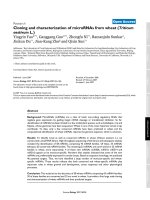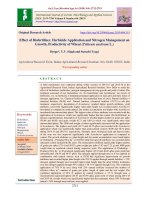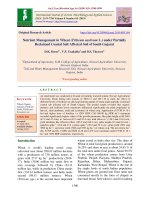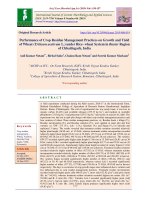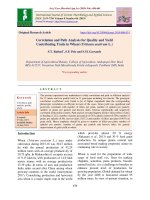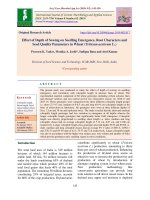Evaluation of herbicides for control of weeds in wheat (Triticum aestivum L.)
Bạn đang xem bản rút gọn của tài liệu. Xem và tải ngay bản đầy đủ của tài liệu tại đây (323.27 KB, 11 trang )
Int.J.Curr.Microbiol.App.Sci (2020) 9(5): 1157-1167
International Journal of Current Microbiology and Applied Sciences
ISSN: 2319-7706 Volume 9 Number 5 (2020)
Journal homepage:
Original Research Article
/>
Evaluation of Herbicides for Control of Weeds in
Wheat (Triticum aestivum L.)
Deepesh Jaiswal1, M. Devender Reddy2*, Girish Pandey3 and Anuj Kumar4
1
2
School of Agriculture, ITM University, Gwalior - 474001, (M.P.), India
M.S. Swaminathan School of Agriculture, Centurion University of Technology and
Management, Paralakhemundi, Odisha -761211, India
*Corresponding author
ABSTRACT
Keywords
Post emergence
herbicides, Weed
control index, Weed
control efficiency,
Wheat
Article Info
Accepted:
05 April 2020
Available Online:
10 May 2020
A field experiment on evaluation of herbicides for control of weeds in wheat (Triticum
aestivum L.) was conducted at School of Agriculture, ITM University, Gwalior, Madhya
Pradesh during the winter season of 2015-16. The experiment comprised of ten post
emergence herbicides application along with weed free and weedy check treatments.
Maximum weed control efficiency was observed in weed free treatment followed by
Sulfosulfuron + Metsulfuron, Isoproturon and Sulfosulfuron treatments. Sulfosulfuron +
Metsulfuron recorded lowest weed index. The maximum grain yield was observed in weed
free which was statistically at par with that observed with application of Sulfosulfuron +
Metsulfuron, Isoproturon, and Sulfosulfuron. Highest straw yield was recorded in
Sulfosulfuron which was statistically at par with weed free, Sulfosulfuron+ Metsulfuron,
Mesosulfuron + Iodosulfuron, Isoproturon, Pinoxaden + Metsulfuron and Pinoxaden + 2,4D-E applied treatments. The lower grain and straw yield was recorded under weedy check
which was significantly inferior to rest of the treatments. The harvest index was in the
range of 40.80 to 47.02 % under different weed control treatments. The results indicate
that application of Sulfosulfuron + metsulfuron (30+2 g ha -1) or isoproturon (1000 g ha-1)
are most remunerative and effective herbicides for weed management in irrigated wheat
under sandy loam soils of Northern Madhya Pradesh.
Introduction
Rumex retroflexus L., Vida sativa L. and
Anagallis arvensis L.
Wheat is one of the most important rabi
cereals contributing 35% of total food grain
production in our country. Heavy infestation
of weeds alone causes 33% reduction in yield
of wheat. Wheat crop gets infested with heavy
population of Phalaris minor Retz., Avena
ludoviciana Dur., Chenopodium album L.,
Melilotus indica All., Coronopus didymus L.,
The critical period of weed control in wheat is
30-45 days after sowing and crop should be
kept weed free during this period. For the
control of complex weed flora (grass and
broadleaf weeds) and to provide long term
residual weed control, application of different
combinations of herbicides is needed. Tank
1157
Int.J.Curr.Microbiol.App.Sci (2020) 9(5): 1157-1167
mix combinations or ready mixtures are
advantageous over sequential application due
to saving in application timing and cost. The
effectiveness of grass herbicides are generally
reduced when mixed with broad-leaved
herbicides (Damalas and Eleftherohorinos,
2001). Synergism/ compatibility have been
found to occur more frequently in mixtures
where the companion herbicides belong to the
same chemical groups (Damalas, 2004).
Sulfosulfuron + Metsulfuron are compatible
(Chhokar et al., 2007) but tank mix
application of grass herbicides (Clodinafop,
Fenoxaprop, Tralkoxydim and Pinoxaden)
with either 2, 4 - D or Metsulfuron is
antagonistic (Mathiassen and Kudsk, 1998).
To avoid antagonism, the grassy and broadleaved herbicides should be applied
sequentially.
For controlling broadleaved weeds along with
grasses, application of Isoproturon in
combination of 2,4-D, Sulfosulfuron and
Metsulfuron-methyl
(MSM)
are
recommended (Pandey et. al., 2006, Singh
and Singh, 2002).
The application of isoproturon + 2,4-D at 1.0
+ 0.5 kg/ha produced significantly higher
grain yield (Kumara et al., 2019). Metribuzin
has been found effective against associated
weeds of wheat (Dixit and Bhan, 1997).
Continuous use of Isoproturon led to the
development of evolutionary resistant biotype
and shift in weed flora (Malik and Singh,
1995).
A number of herbicides are, therefore,
necessary to be evaluated for controlling
weeds from the point of eco-safety and cost
effective as the manual weeding or through
animal drawn are costly. Keeping the above
points in view, an experiment was conducted
to evaluate herbicides for control of weeds in
wheat (Triticum aestivum L) during rabi
season of 2015-16.
Materials and Methods
An experiment was conducted to evaluate
post emergence herbicides for control of
weeds in wheat (Triticum aestivam L.) at ITM
University, Gwalior, Madhya Pradesh during
rabi season of 2015-16. The experiment site
falls under humid sub-tropical climate and
located in between 230 10’ N latitude and 790
54’ E longitudes at an elevation of 411.98
meters above mean sea level. The soil type of
experimental field was sandy loam in nature
with pH of 7.4 and EC 0.29 dsm-1, having 242
kg available nitrogen, 20.5 kg available
phosphorus, 456 kg available potassium, 8.1
kg available sulphur per hectare.
During the crop growth period, the maximum
temperature varied between 18.9 oC in
January third week to 40.1 oC in April first
week and minimum temperature ranged from
3.9 oC in third week of December to 23 oC in
second week of April.
The experiment comprised of ten treatments
of post emergence herbicides and their
combinations along with hand weeding and
no hand weeding (control) (Table 1). The
experiment was laid out in Randomized block
design with three replications.
A pre sowing irrigation was given to the
experimental field and when it came in the
condition, two cross ploughings followed by
planking was done. The plots were prepared
by forming channels and bunds and leveled.
Wheat variety GW-322 was sown by using
seed rate of 100 kg ha-1 on 29 November 2015
with funnel attached desi plough by
maintaining row-to-row distance of 20 cm.
The crop was harvested on April 26, 2016.
First weeding was done at 20 days after
sowing and second at 35 days after sowing in
hand weeded plot. The quantity of herbicides
as per treatments was sprayed by knap – sack
1158
Int.J.Curr.Microbiol.App.Sci (2020) 9(5): 1157-1167
sprayer with flat fan nozzle and the quantity
of water used was 600 l ha-1.
The nutrients were applied at 120 kg N, 60 kg
P2O5 and 40 kg K2O ha-1. The full dose of
P2O5 and K2O and half dose of nitrogen were
drilled at 8 cm deep in the field at the time of
sowing as a basal dose. Remaining half dose
of nitrogen was applied in two equal splits
after first and second irrigation. The nitrogen
was applied through urea, P2O5 through
Single Super Phosphate and K2O through
Mureate of Potash. All the agronomic
management practices were done uniformly in
all the treatments. Six irrigations were given
during the entire period of crop, besides pre
sowing irrigation. The observations on weed
population and weed dry weight were
recorded at 30 DAS and harvest and the weed
control efficiency, weed index were estimated
by using the formulae as given below.
The data on plant height was recorded on five
plants which were tagged randomly in each
treatment from each replication. The
observations on number of tiller per meter
row length and yield attributes number of
effective tiller per meter row length, ear head
length (cm), number of grains per ear head,
1000 grain weight and biological, grain and
straw yield were recorded.
The data obtained on various observations
were subjected to statistical analysis by using
the techniques of the analysis of variance
(ANOVA) and the treatment was tested by F
test and Critical difference (CD) at 5% level
of significance (Panse and Sukhatme, 1989)
for each character to compare the differences
among treatment means.
Results and Discussion
Weeds
Weed control efficiency (%)
Weed flora
Weed control efficiency of the various
treatments were worked out with the help of
the following formula.
XY
100
Weed control efficiency (%) = X
Where,
X = Dry matter production of weeds in
unweeded plot.
Y = Dry matter production of weeds in treated
plot.
Major monocot weeds were Cyperus
rotundus, Phalaris minor and Asphodelus
tenuifolius and major dicot weeds were
Chenopodium album, Anagalis arvensis,
Convolvulus arvensis and Medicago hispida.
Out of these, Cyperus rotundus and
Chenopodium album were the most dominant
of monocot and dicot weeds respectively
(Table 2).
Weed population (density)
Weed index (%)
The weed index (WI) was calculated by using
the following formula (Gill and Vijay Kumar,
1969).
XY
100
W.I. = X
Where, X = Yield from maximum weed free
plot.
Y = Yield from other treated plot.
Weed density (Population per unit area) is an
important and key parameter in figuring out
the impact of treatments on weed growth
(Table 2). All the weed control treatments
significantly reduced the population of
monocot and diocot weeds over weedy check
at 30 days after sowing (DAS) and harvest.
The population of monocot weeds m-2 at 30
DAS and harvest differed significantly among
1159
Int.J.Curr.Microbiol.App.Sci (2020) 9(5): 1157-1167
various treatments (Table 2). Minimum
population of monocot weeds was recorded
under treatment weeds free (T11) which was
significantly lower than rest of all other
treatments. Maximum population was
recorded under weedy check (T12), which
was comparable to other weedicide
treatments. At harvest, all weed control
treatments
significantly
reduced
the
population of monocot weeds over weedy
check. The minimum population was
registered in weed free treatments but this was
statistically at par with Sulfosulfuron +
metsulfuron
(T10),
Mesosulfuron
+
iodosulfuron
(T9),
Isoproturon
(T8),
Sulfosulfuron (T7), Pinoxaden + Metsulfuron
(T6) and Pinoxaden +2,4-D-E(T5) treatments.
The maximum population of monocot weeds
was observed under weedy check. Khan et al.,
(2004) and Chhokar et al., (2007) recorded
significant reduction in weed growth with the
application of herbicides.
The population of diocot weeds at 30 DAS
and harvest differed significantly due to
different treatments (Table 2). The major
dicot weeds observed were Chenopodium
album, Anagalis arvensis, Convolvulus
arvensis and Medicago hispida. At 30 DAS,
the minimum population of diocot weeds was
recorded under weed free (T11) treatment
which was significantly lower over rest of the
treatments. The maximum population of dicot
weeds was recorded in weedy check, which
was comparable to all the weedicides
treatments. At harvest, minimum population
of diocot weeds was noted in weed free
treatment (T11) which was at par with
Sulfosulfuron + metsulfuron(T10), Isoproturon
(T8) and Pinoxaden +2,4-D-E(T5), treatments.
The maximum population of diocot weeds
was recorded in Weedy check.
The least weed density in herbicide treatments
might be due to their phytotoxicity against
diverse and disruptive weed flora. These
findings were in harmony with that of Khan et
al., (2001). They reported that grassy and
broadleaf weeds were controlled very
effectively by the application of herbicides
(Hassan et al., 2003; Khan et al., 2004 and
Jarwar et al., 2005).
Weed dry weight (g m-2)
At 30 DAS, significantly lower weed dry
weight was recorded under the weed free
(T11) treatment (Table 2). Whereas, maximum
dry weight was found under weedy check
(T12). At this stage, the weed dry matter in all
the weedicide treatments was comparable. At
harvest, all the weed control treatments
resulted significantly lower weed dry weight
as compared to weedy check. The minimum
weed dry weight was recorded under weed
free treatment (T11) but was at par with
Sulfosulfuron
+
metsulfuron
(T10),
Mesosulfuron + iodosulfuron (T9), Pinoxaden
+2,4-D-E
(T5),
Sulfosulfuron
(T7),
Isoproturon (T8), and Pinoxaden +
Metsulfuron (T6). The maximum weed dry
weight was recorded in weedy check.
The application of Sulfosulfuron +
Metsulfuron, Mesosulfuron + Iodosulfuron,
Isoproturon and Sulfosulfuron was effective
in controlling weeds as compared to rest of
the treatments as these herbicides controlled
both narrow and broad leaf weeds (Pandey et
al., 2006) owing to synergetic enhancement.
Herbicidal combinations in general were
better than sole application of herbicides in
efficiency reducing the total weed dry weight.
Weed control efficiency (%)
Maximum weed control efficiency (92.5%)
was recorded in weed free (T11) treatment
(Table 2). Under different weedicides
treatments, maximum weed control efficiency
was noted with Sulfosulfuron + Metsulfuron
treatment (T10) and it was followed by
1160
Int.J.Curr.Microbiol.App.Sci (2020) 9(5): 1157-1167
Mesosulfuron
+
Iodosulfuron
(T9),
Pinoxaden +2,4-D-E (T5), Isoproturon (T8),
Pinoxaden + Metsulfuron (T6) and
Sulfosulfuron (T7) treatments with 86.2, 84.6,
81.7, 81.3 and 80.9 per cent weed control
efficiency, respectively. Because of better
control of weeds under the herbicide mixture,
weed control efficiency under these
treatments was comparable to weed free.
Meena et al., (2017) reported that application
of tank mixed metsulfuron + sulfosulfuron
mixture provided maximum per cent
reduction in density and dry matter (90.05 &
95.35%) of total weeds over unweeded
control followed by mesosulfuron +
iodosulfuron, clodinofop + metsulfuron and
pinoxaden + metsulfuron (88.8, 88.0 and 87.4
& 94.7, 94.4 and 94.2%) at 60 DAS which
resulted into highest weed control efficiency
(95.4, 94.7, 94.4 and 94.2%) and proved
significantly superior over rest of the
herbicidal
treatments.
Application
of
herbicide alone gave poor control of weeds,
therefore had lower weed control efficiency.
These results are in close conformity with
findings of Yadav et al., (2009) and Chopra
and Chopra (2005).
Weed index (%)
The weed index ranged from 2.04 to 52.04 %
under different treatments (Table 2). The
treatment Sulfosulfuron + Metsulfuron (T10)
recorded lowest weed index. Application of
Isoproturon (T8) and Mesosulfuron +
Iodosulfuron (T9) observed 5.21 and 5.99 %
weed index. Whereas, weedy check showed
maximum (41.23%) weed index.
Crop
Growth parameters
Plant population (m-1 row length) of wheat at
initial and harvest stage was not significantly
affected by any of the weed control treatments
(Table 3). The weed control treatments
significantly influenced the morphological
parameters like plant height; number of tillers
per plant at harvest.
At harvest, higher plant height was observed
in weed free (T11) treatment which was at par
with application of Pinoxaden + Metsulfuron
(T6), Sulfosulfuron + Metsulfuron (T10),
Mesosulfuron
+
Iodosulfuron
(T9),
Isoproturon (T8). The minimum height was
noted in weedy check (T12) treatment.
At harvest, number of tillers ranged from 8.75
to 14.57 per plant under different treatments
(Table 3). At this stage, maximum number of
tillers were obtained in treatment weed free
(T11) and comparable with Sulfosulfuron +
metsulfuron(T10),
Mesosulfuron
+
iodosulfuron(T9),
Pinoxaden
+
Metsulfuron(T6),
Sulfosulfuron(T7)
and
Isoproturon (T8) treatments and minimum
number of tillers were observed in weedy
check treatment (T12).
Yield attributes
The number of ear-heads per meter row
length; length of ear-head, number of grains
per ear-head, weight of ear head and test
weight were significantly influenced due to
weed control treatments (Table 4).
The maximum number of ear-heads were
recorded with application of Sulfosulfuron +
Metsulfuron (T10), which was closely
followed by weed free treatment (T11).
However, the number of ear-heads per meter
row length recorded in treatments,
Mesosulfuron
+
Iodosulfuron
(T9),
Isoproturon (T8) and Pinoxaden + 2,4-D-E
(T5) were statistically at par with each other.
Whereas, minimum number of ear-heads were
recorded under weedy check (T12) treatment.
The longest ear head was observed in weed
free treatment (T11) which was statistically at
par with those received herbicides which
1161
Int.J.Curr.Microbiol.App.Sci (2020) 9(5): 1157-1167
controlled the grassy and broad leaf weeds,
i.e. Pinoxaden +2,4-D-E(T5), Pinoxaden +
Metsulfuron
(T6),
Sulfosulfuron
(T7),
Isoproturon
(T8),
Mesosulfuron
+
iodosulfuron (T9) and Sulfosulfuron +
metsulfuron (T10) treatments (Table 4). While,
shorter ear head were observed under weedy
check treatment.
Among the yield components, number of
grains per spike is imperative parameter for
assessment of the impact of weed
management treatments on yield. Increasing
the number of grains per spike will increase
the weight of the spike which in turn
improves the yield (Table 4). All the weed
management treatments significantly boosted
the number of grains per spike. Different
chemical treatments had significant effects on
grains per spike. The maximum number of
grains and ear head weight was noted in weed
free treatment (T11) and it was significantly
higher than that observed under 2,4-D-E (T1),
Metsulfuron (T2), Pinoxaden (T3), and
Clodinafop (T4) treatments. Under different
herbicidal treatments, Pinoxaden +2,4-DE(T5), Pinoxaden + Metsulfuron (T6),
Sulfosulfuron
(T7),
Isoproturon
(T8),
Mesosulfuron + iodosulfuron (T9) and
Sulfosulfuron + metsulfuron (T10) recorded
statistically comparable number of grains per
ear-head and their weight, while minimum
values were observed under weedy check
treatment (T12).
A significant impact was noted due to
different weed control treatments on 1000grain
weight.
The
treatment
T10
(Sulfosulfuron + Metsulfuron T10) produced
the maximum test weight (42.82 g), closely
followed by weed free treatment T10.
Minimum 1000 grain weight was observed in
weedy check (T12) treatment. However,
treatments,
Pinoxaden
+2,4-D-E(T5),
Pinoxaden + Metsulfuron(T6), Sulfosulfuron
(T7), Isoproturon (T8), and Mesosulfuron +
iodosulfuron (T9) were at par and recorded
significantly higher 1000-grain weight over
2,4-D-E (T1), Metsulfuron (T2), Pinoxaden
(T3), and Clodinafop (T4) treatments (Table 4).
Table.1 Details of treatments and their symbols
S. No.
Treatments
1
2.
3.
4.
5.
6.
7.
8.
9.
10.
11.
12.
2,4-D-E
Metsulfuron
Pinoxaden
Clodinafop
Pinoxaden +2,4-D-E
Pinoxaden + Metsulfuron
Sulfosulfuron
Isoproturon
Atlantis (Mesosulfuron + iodosulfuron)
Total (Sulfosulfuron + metsulfuron)
Weed free (Two HW at 30 & 50 DAYS)
Weedy check
Dose
(g h-1)
500
4
40
60
40+500
40+4
25
1000
12+2.4
30+2
1162
Symbols
T1
T2
T3
T4
T5
T6
T7
T8
T9
T10
T11
T12
Weed Control
Grasses
Broad leaf
√
√
√
√
√
√
√
√
√
√
√
√
√
√
√
√
Int.J.Curr.Microbiol.App.Sci (2020) 9(5): 1157-1167
Table.2 Effect of different treatments on population of monocot and dicot weeds per square
meter in wheat
Weed population, number m-2
Treatments
2,4-D-E
Metsulfuron
Pinoxaden
Clodinafop
Pinoxaden +2,4D-E
Pinoxaden +
Metsulfuron
Sulfosulfuron
Isoproturon
9.67
(3.11)
8.33
(1.79)
5.33
(2.27)
2.67
(1.57)
3.00
(1.73)
2.33
(1.53)
2.33
(1.53)
3.33
(1.82)
2.00
(1.41)
10.33
(3.21)
9.67
(3.11)
10.00
(3.16)
10.67
(3.27)
9.67
(3.11)
10.00
(3.16)
9.67
(3.11)
9.33
(3.05)
9.67
(3.11)
5.00
(2.24)
5.33
(2.31)
8.00
(2.83)
9.33
(3.05)
3.00
(1.73)
4.33
(2.08)
3.67
(1.92)
3.00
(1.73)
4.00
(2.00)
14.96
4.0
Weed
control
efficiency,
%
Av. (60, 90
DAS &
harvest)
75.7
15.54
3.16
77.8
22.70
14.44
3.44
77.8
19.23
14.92
4.12
77.8
19.12
13.88
1.88
86.1
9.81
14.28
2.44
82.4
7.81
15.12
2.08
83.3
7.18
13.65
2.16
81.8
5.21
13.55
1.44
87.7
5.99
1.33
(1.15)
9.33
(3.05)
1.33
(1.15)
12.88
1.26
89.5
2.04
1.00
(1.00)
1.33
(1.15)
1.00
(1.00)
1.14
1.08
92.5
0.00
15.00
(3.87)
0.75
2.20
11.33
(3.37)
1.05
3.10
17.67
(4.20)
0.73
2.16
19.42
23.04
0.0
52.04
0.84
2.48
0.70
2.07
Days after sowing
Monocot
Dicot
30 Maturity
30
Maturity
9.33
(3.05)
9.00
(1.63)
9.67
(3.11)
10.00
(3.16)
9.33
(3.05)
9.67
(3.11)
10.67
(3.27)
11.00
(3.29)
9.00
(3.00)
Atlantis
(Mesosulfuron +
iodosulfuron)
9.33
Total
(Sulfosulfuron + (3.05)
metsulfuron)
Weed free (Two 2.00
HW at 30 & 50 (1.41)
DAS)
11.33
Weedy check
(3.37)
0.82
S.Em.
C.D. at 5%
2.42
Figure in parenthesis indicate the transformation values.
1163
Weed dry weight,
g m-2
Days after sowing
30
Harvest
Weed
index,
%
19.03
Int.J.Curr.Microbiol.App.Sci (2020) 9(5): 1157-1167
Table.3 Effect of different treatments on the plant population meter-2 row length of wheat
Tr. No.
T1
T2
T3
T4
T5
T6
T7
T8
T9
T10
T11
T12
Treatments
Plant population
Per meter row length
2,4-D-E
Metsulfuron
Pinoxaden
Clodinafop
Pinoxaden +2,4-D-E
Pinoxaden + Metsulfuron
Sulfosulfuron
Isoproturon
Atlantis (Mesosulfuron +
iodosulfuron)
Total (Sulfosulfuron + metsulfuron)
Weed free (Two HW at 30 & 50
DAS)
Weedy check
S.Em.
C.D. at 5%
30 DAS
18.16
18.30
17.50
18.66
17.45
17.89
18.22
18.11
17.94
Harvest
16.79
16.62
16.21
16.62
16.16
17.18
16.87
16.51
16.90
Plant
height at
harvest,
cm
88.24
88.86
87.24
90.06
95.00
100.61
96.15
98.65
99.16
99.85
Tillers per
culm at
harvest,
number
11.19
11.62
11.44
11.16
12.34
13.64
13.43
13.32
14.02
14.23
18.00
18.11
16.97
16.97
104.60
79.24
14.57
8.75
18.33
0.32
NS
16.31
0.31
NS
2.46
7.22
88.24
0.54
1.60
11.19
Table.4 Yield attributing character of wheat as influenced by weed control treatments
Tr. Treatments
No.
T1
T2
T3
T4
T5
T6
T7
T8
T9
T10
T11
T12
2,4-D-E
Metsulfuron
Pinoxaden
Clodinafop
Pinoxaden +2,4-D-E
Pinoxaden + Metsulfuron
Sulfosulfuron
Isoproturon
Atlantis (Mesosulfuron + iodosulfuron)
Total (Sulfosulfuron + metsulfuron)
Weed free (Two HW at 30 & 50 DAS)
Weedy check
S.Em.
C.D. at 5%
Number of
ear-heads
/m row
length
47.61
48.91
49.77
49.64
55.58
52.59
52.29
55.26
55.87
58.58
57.96
34.32
1.50
4.39
1164
Length of
earhead
(cm)
Number
of grains
earhead-
Weight
of ear
head (g)
Test
weight
(g)
8.62
8.56
8.59
8.60
9.59
9.64
9.73
9.96
9.90
9.99
10.02
7.80
0.20
0.59
38.98
38.75
38.85
38.91
42.06
42.02
41.63
41.61
42.22
42.82
42.70
33.94
0.86
2.53
1
7.47
7.42
7.44
7.45
8.31
8.50
8.55
8.74
8.66
8.78
8.88
6.76
0.21
0.61
36.33
36.18
36.22
36.30
40.45
41.34
41.60
42.51
42.15
42.70
43.22
32.84
1.01
2.95
Int.J.Curr.Microbiol.App.Sci (2020) 9(5): 1157-1167
Table.5 Effect of different treatments on grain, straw and biological yield (kg ha-1) and
harvest index (%) of wheat
Tr. Treatments
No.
T1
T2
T3
T4
T5
T6
T7
T8
T9
T10
T11
T12
Grain
yield
(Kg ha-1)
3731
3562
3722
3727
4156
4248
4277
4368
4332
4514
4608
2210
120
351
2,4-D-E
Metsulfuron
Pinoxaden
Clodinafop
Pinoxaden +2,4-D-E
Pinoxaden + Metsulfuron
Sulfosulfuron
Isoproturon
Atlantis (Mesosulfuron + iodosulfuron)
Total (Sulfosulfuron + metsulfuron)
Weed free (Two HW at 30 & 50 DAS)
Weedy check
S.Em.
C.D. at 5%
Straw
yield
(kg ha-1)
4686
4613
4631
4847
5137
5196
5250
5153
5052
5141
5187
3198
121
354
Biological
yield
(kg ha-1)
8417
8175
8352
8574
9293
9445
9527
9521
9384
9655
9795
5408
221
647
Harvest
index
(%)
44.34
43.55
44.57
43.47
44.72
44.99
44.87
45.88
46.16
46.75
47.02
40.80
0.69
2.01
et al., 2012; Shahzad et al., 2012; Hussain et
al., 2013; Singh et al., 2013).
Yield
Significant effect on wheat grain yield was
noticed among various herbicide treatments
(Table 5). The maximum grain yield was
obtained in weed free treatment which was
statistically at par with Sulfosulfuron +
Metsulfuron (T10) herbicide treatnent. The
grain yield observed with application of
Isoproturon
(T8),
Mesosulfuron
+
Iodosulfuron(T9)
and Sulfosulfuron (T7)
were also statistically comparable to each
other. Due to maximum infestation of weeds,
the lowest wheat grain yield was recorded in
the weedy check plots.
The higher grain yield in herbicides treated
plots is due to better control of grassy and
broad-leaved weeds thus the crop was able to
utilize the available resources more
efficiently. Similar findings were reported by
earlier researchers (Hassan et al., 2003; Tunio
et al., 2004; Hesammi et al., 2010; Mahmood
All weed control treatments significantly
increased the straw yield over weedy check
(Table 5). Highest straw yield was recorded in
Sulfosulfuron treated plot which was
statistically at par with that of weed free (T11),
Sulfosulfuron+
Metsulfuron
(T10),
Mesosulfuron
+
Iodosulfuron
(T9),
Isoproturon (T8), Pinoxaden + Metsulfuron
(T6) and Pinoxaden + 2,4-D-E (T5) treated
plots. The lower straw yield was recorded
under weedy check which was significantly
inferior to that under rest of the treatments.
The highest straw yield could be owing to the
better management of mono and dicot weeds
by herbicidal treatments and thus the crop was
capable to make use of the available resources
more proficiently. The similar findings were
reported previously by researchers (Khan et
al., 2003; Singh et al., 2013).
1165
Int.J.Curr.Microbiol.App.Sci (2020) 9(5): 1157-1167
The biological yield ranged from 5408 to
9795 kg ha-1 under different weed control
treatments. Significantly greater biological
yield was noted in treatment weed free (T11)
which was statistically at par with
Sulfosulfuron
+
metsulfuron
(T10),
Mesosulfuron
+
iodosulfuron
(T9),
Isoproturon
(T8),
Sulfosulfuron
(T7),
Pinoxaden + Metsulfuron (T6) and Pinoxaden
+2,4-D-E (T5) treatments (Table 5).
Significantly lower biological yield was
recorded by the treatment weedy check (T12)
which was found to be statistically inferior to
rest of the treatments.
The harvest index was in the range of 40.80 to
47.02 % under different weed control
treatments. Maximum harvest index (47.02
%) was observed under weed free (T11)
treatment which was comparable with
Sulfosulfuron
+
metsulfuron
(T10),
Mesosulfuron
+
iodosulfuron
(T9),
Isoproturon (T8) treatments. Minimum harvest
index (40.80%) was observed under weedy
check treatment.
From present study, it can be concluded that
Sulfosulfuron + metsulfuron (30+2 g ha-1) or
isoproturon (1000 g ha-1) are most
remunerative and effective herbicides for
weed management in irrigated wheat under
sandy loam soils of Northern Madhya
Pradesh.
References
Chhokar, R. S., Sharma, R. K., Jat, G. R.,
Pundir, A. K. and Gathala, M. K. (2007)
Effect of tillage and herbicides on
weeds and productivity of wheat under
rice-wheat growing system. Crop
Protection 26: 1689-1696.
Chopra, N. and Chopra, N. K. (2005) Bioefficacy of fenoxaprop, clodinafop,
metribuzin alone and in combinations
against weeds in wheat and their
residual effect on succeeding crops.
Indian Journal of Weed Science 37
(3&4): 163-166.
Damalas, C. A. and Eleftherohorinos, I. G.
(2001)
Dicamba
and
atrazine
antagonism on sulfonylurea herbicides
used for Johnsongrass (Sorghum
halepense) control in corn
Damalas, C. A. (2004). Herbicide tank
mixtures:
Common
interactions.
International Journal of Agriculture
Biology, 6: 209-212.
Dixit, A. and Bhan, V. M. (1997) Efficiency
of metribuzin for controlling weeds in
wheat. Ann. Rep. NRC Weed Sci. pp.
23.
Hassan, G., Faiz, B., Marwat, K. B. and
Khan, M. (2003) Effects of planting
method and tank mixed herbicides on
controlling grassy and broadleaf weeds
and their effect on wheat cv Fakhr-eSarhad. Pak. J. Weed Sci. Res., 9: 1-11.
Jarwar, A. D., Arain, M. A. and Rajput L. S.
(2005) Chemical weed control in wheat.
Pak. J. Weed Sci. Res., 11: 11-15.
Khan, I., Hassan, G., Khan, M. A. and Khan
M. I. (2004) Efficacy of some new
herbicides on both grassy and broad leaf
weeds in wheat. II. Pak. J. Weed Sci.
Res., 10: 33-38.
Khan, I. U., Muhammad, Z., Hassan, G. and
Marwat, K. B. (2001) Efficacy of
different herbicides for controlling
weeds in wheat crop.I. Response of
agronomic and morphological traits in
wheat variety Ghaznavi. Sci. Khyber,
14: 51-57.
Khan, N., Hassan, G., Khan, M. A. and Khan,
I. (2003) Efficacy of different
herbicides for controlling weeds in
wheat crop at different times of
application-I. Asian J. Plant Sci., 2:
305-309.
Kumara, S., Ranaa, S.S., Badiyalaa, D.,
Suresh Kumara, Sharma, N. (2019).
Bioefficacy
of
post-emergence
1166
Int.J.Curr.Microbiol.App.Sci (2020) 9(5): 1157-1167
herbicide
Prioxofop-Propanyl
(Markclodina) against weeds in wheat.
Journal of Research in Weed Science 2
(2019) 141-148
Malik, R. K. and Singh, S. (1995) Little seed
canarygrass (Phalaris minor Retz.)
resistance to isoproturon in India. Weed
Technology 9: 419-425.
Mathiassen, S. K. and Kudsk, P. (1998)
Influence
of
broadleaved
weed
herbicides
on
the
activity of
fenoxaprop-p-ethyl. Weed Research 38:
283-289.
Meena, V., Kaushik, M.K., Meena, S.K.,
Bhimwal, J.P. and Chouhan, B.S.
(2017). Influence of pre and post
emergence herbicide application on
weed growth and nutrient removal in
wheat (Triticum aestivum L.). Journal of
Pharmacognosy and Phytochemistry.
6(6): 2413-2418
Pandey, I. B., Dwivedi, D. K. and Pandey, R.
K. (2006) Efficacy of herbicides and
fertilizer
management
on
weed
dynamics
of
wheat.
National
Symposium
on
Conservation
Agriculture and Environment, October
26-28, at BHU, Varanasi, India, pp.
336-337.
Panse, V.G. and Sukhatme, P.V. (1989).
Statistical methods for agriculture of
workers. 5th Ed. ICAR, New Delhi.
Singh, G. and Singh, M. (2002) Bio-efficacy
of metsulfuron methyl in combination
with isoproturon for control of grassy
and non grassy weeds in wheat. Indian
J. Weed Sc. 34: 9-12.
Singh, G. and Singh, M. (2002) Bio-efficacy
of metsulfuron methyl in combination
with isoproturon for control of grassy
and non grassy weeds in wheat. Indian
J. Weed Sc. 34: 9-12.
Singh, R. K., Singh, S. R. K. and Gautam, U.
S. (2013) Weed Control Efficiency of
herbicides in Irrigated Wheat (Triticum
aestivum). Indian Res. J. Ext. Edu., 13:
126-128.
Yadav, D. B., Punia, S. S., Yadav A. and Lal
R.
(2009)
Compatibility
of
sulfosulfuron with carfentrazone-ethyl
for the control of complex weeds flora
in wheat.
How to cite this article:
Deepesh Jaiswal, M. Devender Reddy, Girish Pandey and Anuj Kumar. 2020. Evaluation of
Herbicides
for
Control
of
Weeds
in
Wheat
(Triticum
aestivum
L.).
Int.J.Curr.Microbiol.App.Sci. 9(05): 1157-1167. doi: />
1167
